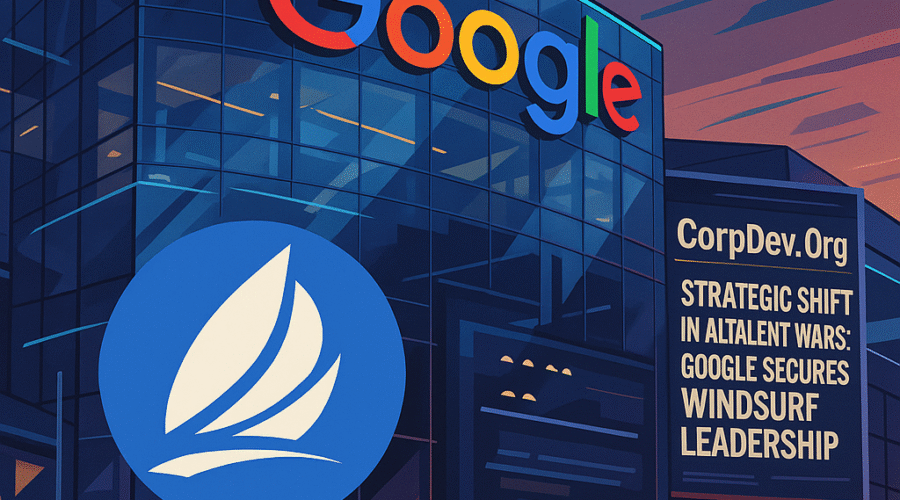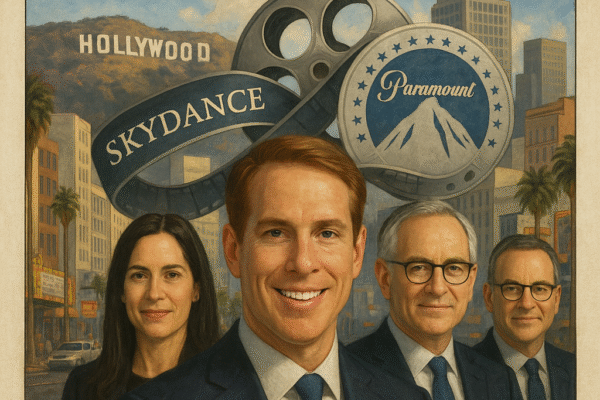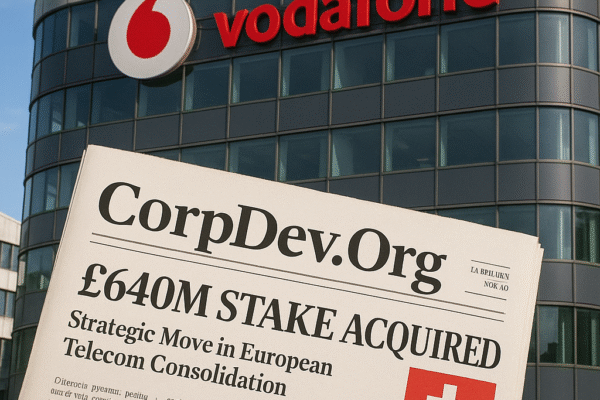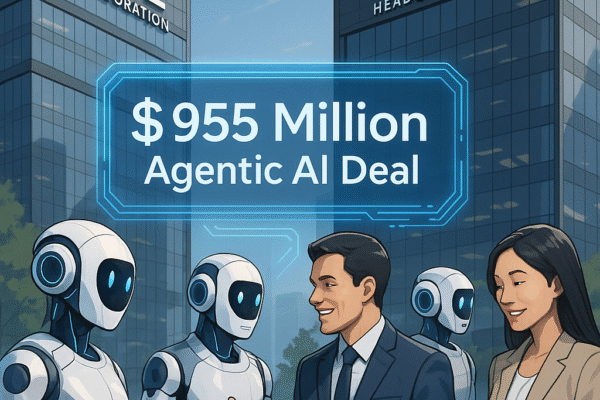In a dramatic realignment of artificial intelligence talent acquisition, Google DeepMind has hired Windsurf CEO Varun Mohan, co-founder Douglas Chen, and key technical staff following the collapse of OpenAI’s planned $3 billion acquisition of the AI coding startup. This reverse-acquihire deal—where Google obtains talent and non-exclusive technology licensing without corporate acquisition—represents a significant strategic victory for Alphabet in the intensifying battle for AI dominance. The transaction, valued at approximately $2.4 billion for talent compensation and technology licensing according to financial sources[14], underscores how major tech firms are circumventing regulatory scrutiny while securing critical expertise in agentic coding systems. This development fundamentally reshapes the competitive dynamics between OpenAI, Microsoft, and Google in the enterprise AI development tools market, with implications for valuation models, talent retention strategies, and product roadmaps across the sector.
💼 M&A / PE diligence in 24 hours? Yes, thanks to AI!
The Unraveling of OpenAI’s Acquisition Strategy
Exclusive Negotiations and Breakdown Factors
OpenAI had entered exclusive negotiations to acquire Windsurf for approximately $3 billion in May 2025, a deal that would have represented the ChatGPT developer’s largest acquisition to date[3][6]. The acquisition was strategically positioned to enhance OpenAI’s capabilities in AI-assisted software development, directly competing with Microsoft’s GitHub Copilot. However, multiple factors contributed to the deal’s collapse as the exclusivity window expired in early July. Regulatory concerns emerged as a significant complication, particularly regarding Microsoft’s potential access to Windsurf’s intellectual property through its $13 billion partnership with OpenAI[4][9]. Industry analysts noted that Microsoft, which markets the competing Copilot coding assistant, expressed reservations about the acquisition creating conflicts within its strategic partnership with OpenAI[3][9]. Additionally, due diligence revealed challenges in integrating Windsurf’s “vibe coding” technology—which focuses on contextual understanding of developer workflows—with OpenAI’s existing infrastructure[7][13].
Post-Collapse Fallout and Immediate Consequences
When exclusivity lapsed without a finalized agreement, Windsurf became free to engage with other suitors, creating an immediate opportunity for competitive bidding[6][8]. The breakdown represents a significant setback for OpenAI, which has faced multiple high-profile talent departures to rivals including Meta in recent months[6][11]. More critically, the failed acquisition leaves OpenAI without a proprietary integrated development environment (IDE) at a time when major competitors are embedding AI coding assistants directly into development workflows[7][13]. Market analysts at Contrary Research note that specialized coding assistants like Windsurf face existential pressure from increasingly capable foundation models like Anthropic’s Claude 4 and Google’s Gemini 2.5, which offer competitive coding capabilities without specialized tooling[8][13]. This technological shift likely influenced OpenAI’s decision to abandon the acquisition at the reported valuation.
Google’s Strategic Countermove: Terms and Mechanics
Deal Structure and Financial Engineering
Google executed a sophisticated reverse-acquihire transaction valued at $2.4 billion, structured as compensation for key personnel and non-exclusive technology licensing rather than a traditional acquisition[14]. Under the agreement, Google gains: 1) Employment contracts for CEO Varun Mohan, co-founder Douglas Chen, and core R&D staff focused on agentic coding; 2) A non-exclusive license to specific Windsurf technologies for integration with Google’s Gemini project; and 3) No equity stake or control over Windsurf’s operations[1][3][11]. This structure intentionally avoids triggering antitrust reviews while providing immediate access to critical talent and IP. Financial terms include substantial upfront compensation and long-term incentives in Alphabet stock, with investors receiving liquidity through special distributions rather than acquisition proceeds[11][14]. The transaction exemplifies a growing trend where Big Tech prioritizes talent acquisition over corporate M&A to bypass regulatory hurdles.
Strategic Integration with DeepMind’s Roadmap
The Windsurf team will embed directly within Google DeepMind’s Gemini project, focusing on developing “agentic coding” capabilities that enable AI systems to autonomously plan, execute, and refine complex software development tasks[1][10]. Mohan will lead initiatives to enhance Gemini’s contextual understanding of developer environments, building on Windsurf’s signature “vibe coding” approach that interprets programmer intent through integrated development environment (IDE) interactions[5][13]. Google’s spokesperson explicitly stated the hires will “advance our work in agentic coding” and expand Gemini’s capabilities for software developers[3][10]. This integration accelerates Google’s roadmap against Microsoft’s GitHub Copilot, particularly in enterprise environments where Windsurf had established significant traction with clients including JPMorgan Chase, Dell, and Anduril[13]. The non-exclusive licensing component allows Google to leverage Windsurf’s patented context-awareness algorithms while Windsurf continues serving existing enterprise customers.
Windsurf’s Technology and Market Position
Evolution from Codeium to AI Development Platform
Founded in 2021 as Exafunction by MIT graduates Mohan and Chen, the company initially focused on GPU virtualization before pivoting to AI coding assistance and rebranding as Codeium in 2022[13]. The 2024 launch of the Windsurf Editor marked its transition from IDE plugin to full AI-native development environment, culminating in the April 2025 rebrand to Windsurf to reflect its expanded capabilities[8][13]. The platform’s differentiation centers on three core technologies: 1) Real-time code generation with contextual awareness of entire projects; 2) Autonomous debugging and optimization agents; and 3) Personalization engines that adapt to individual coding styles and enterprise codebases[13]. This technological stack drove remarkable traction, reaching 1 million downloads by February 2024 and achieving $100 million in annual recurring revenue by April 2025—an 8x increase in just four months[13].
Enterprise Adoption and Security Credentials
Windsurf achieved several industry milestones that made it an attractive acquisition target, including becoming the first AI coding assistant to receive FedRAMP High Authorization in March 2025—enabling deployment in regulated government and financial services environments[13]. The platform’s architecture processes over 150 billion tokens daily while maintaining strict code isolation between clients, a critical feature for enterprise adoption[13]. Windsurf’s go-to-market strategy focused on large organizations with complex compliance requirements, securing clients like Zillow and JPMorgan Chase through personalized on-premises deployments[13]. This enterprise footprint provided strategic value to both OpenAI (seeking enterprise distribution) and Google (enhancing Gemini for business applications). Despite the leadership departure, Windsurf retains its FedRAMP certification and enterprise customer base, though its technological roadmap faces uncertainty without key architects.
Leadership Transition and Corporate Continuity
New Executive Structure
With Mohan and Chen departing for Google, Windsurf appointed Jeff Wang as interim CEO and Graham Moreno as president, effective immediately[8][11]. Wang previously served as head of business development, where he established partnerships with major cloud providers and enterprise software vendors[8]. Moreno, formerly vice president of global sales, brings relationships with Windsurf’s largest enterprise accounts[11]. This leadership transition prioritizes continuity in customer relationships and revenue operations rather than technological innovation. Crucially, approximately 200 of Windsurf’s 250 employees remain with the company, primarily in sales, support, and implementation roles[1][3]. The
Sources
https://techcrunch.com/2025/07/11/windsurfs-ceo-goes-to-google-openais-acquisition-falls-apart/, https://news.ssbcrack.com/google-deepmind-hires-windsurf-leadership-after-openai-acquisition-falls-through/, https://devops.com/openais-3-billion-deal-to-buy-windsurf-unravels-google-nabs-company-execs-licensing-rights/, https://www.theinformation.com/articles/openai-windsurf-break-acquisition-talks-microsoft-ip-concerns, https://economictimes.com/news/international/us/google-hires-windsurf-ceo-varun-mohan-and-team-amid-ai-talent-war-skips-3billion-openai-deal/articleshow/122396642.cms, https://mlq.ai/news/openais-3-billion-windsurf-acquisition-collapses-as-google-poaches-team-and-tech/, https://www.ignorance.ai/p/the-3-billion-ide, https://www.maginative.com/article/openais-windsurf-deal-is-dead-google-just-poached-the-ceo-instead/, https://news.ycombinator.com/item?id=44536988, https://wiky.com/2025/07/11/google-hires-windsurf-ceo-and-researchers-to-advance-ai-ambitions/, https://economictimes.com/tech/artificial-intelligence/google-hires-windsurf-ceo-and-researchers-to-advance-ai-ambitions-openai-acquisition-falls-apart/articleshow/122398133.cms, https://finimize.com/content/google-strengthens-ai-edge-with-windsurf-talent-acquisition, https://research.contrary.com/company/windsurf, https://www.tradingview.com/news/reuters.com,2025:newsml_FWN3T80RN:0-google-to-pay-2-4-billion-to-license-windsurf-s-technology-hire-its-key-employees-source/





